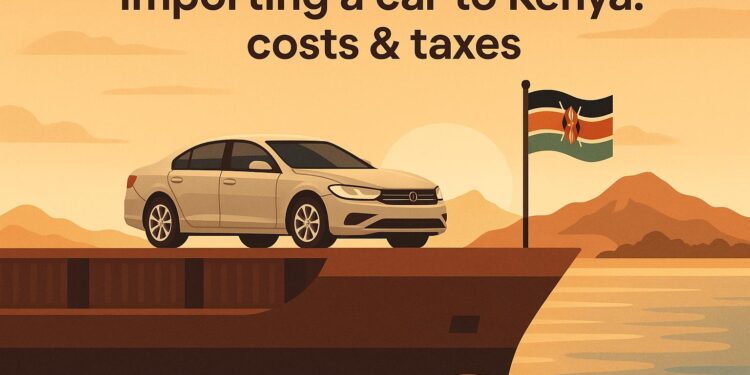Importing a car to Kenya can be costly due to various taxes and fees. Here’s a quick breakdown of what you’ll pay:
- Import Duty: 35% of CIF (Cost, Insurance, and Freight) value.
- Excise Duty: 20% (≤1500cc) or 25% (>1500cc) on CIF + Import Duty.
- VAT: 16% on CIF + Import Duty + Excise Duty.
- Rail Development Levy (RDL): 2% of CIF.
- Import Declaration Fee (IDF): 3.5% of CIF.
For a car with a CIF value of $10,000 and an engine capacity of 1,800cc:
- Import Duty: $3,500
- Excise Duty: $3,375
- VAT: $2,780
- RDL: $200
- IDF: $350
- Total Taxes and Fees: ~$10,205 (excluding extra costs like port charges, agent fees, and local transport).
Key Rules:
- Vehicles must be ≤8 years old.
- Right-hand drive is required (exceptions for special-purpose vehicles).
- All documents, including the original logbook and roadworthiness certificate, are mandatory.
Pro Tip: Hire a licensed clearing agent to streamline the process and avoid delays. Always calculate the total cost before committing to an import.
HOW TO CALCULATE KRA CAR DUTY/ KRA CAR IMPORT …
Import Taxes and Fees
To accurately estimate costs when importing a vehicle into Kenya, it’s important to understand the taxes and fees involved. The Kenya Revenue Authority (KRA) calculates these charges based on the Customs Value (CIF), which includes the car’s invoice value, insurance, and freight charges. Here’s a breakdown of the key components.
Import Duty (35%)
The import duty is set at 35% of the vehicle’s CIF value and applies to all vehicles. For example, if a car has a CIF value of $10,000, the import duty would be $3,500.
Excise Duty Rates
Excise duty is determined by the vehicle’s engine capacity and is calculated on the sum of the CIF value and import duty.
| Engine Capacity | Excise Duty Rate |
|---|---|
| 1,500cc and below | 20% |
| Above 1,500cc | 25% |
For instance, a Toyota Auris with an 1,800cc engine and a CIF value of $10,000 would incur excise duty of 25% on ($10,000 + $3,500), which equals $3,375.
VAT (16%)
Value Added Tax (VAT) is applied to the total of the CIF value, import duty, and excise duty. Using the same Toyota Auris example:
- Base for VAT: $10,000 (CIF) + $3,500 (Import Duty) + $3,375 (Excise Duty) = $16,875
- VAT amount: 16% of $16,875, which is $2,780.
Additional Fees
There are two additional levies you need to account for:
| Fee Type | Rate | Calculation Base |
|---|---|---|
| Rail Development Levy | 2% | CIF Value |
| Import Declaration Fee | 3.5% | CIF Value |
For the Toyota Auris with a CIF value of $10,000:
- Rail Development Levy: $200 (2% of CIF)
- Import Declaration Fee: $350 (3.5% of CIF)
These fees must be paid before the vehicle clears customs. The KRA uses its Current Retail Selling Price (CRSP) system to finalize the customs value, taking into account factors like the vehicle’s age and depreciation.
Cost Calculator Guide
Follow these steps to calculate total import costs and plan your budget effectively.
Cost Formula
Start with the CIF value – this includes the purchase price, shipping costs, and marine insurance. Once you have this figure, apply the relevant taxes as outlined below.
For instance, if the CIF value of an 1800cc vehicle is $10,000, you can expect approximately:
- Import duty: $3,500
- Excise duty: $3,375
- VAT: $2,780
- Fees for RDL and IDF
This brings the total to about $10,205.
Keep in mind, additional costs beyond these primary taxes can influence your final total.
Extra Costs
In addition to standard taxes and duties, prepare for these additional expenses:
- Port charges
- Vehicle verification fees
- Interpol clearance fees
- Customs agent fees
- Local transportation
These fees can vary depending on the service provider.
"When you decide to import a car into Kenya, understanding the breakdown of costs is crucial. The total expense is not just about the purchase price; it includes a variety of duties and taxes mandated by the Kenya Revenue Authority (KRA)."
Tips for Managing Costs
- Act quickly: Clear your vehicle promptly to avoid extra storage fees.
- Factor in depreciation: KRA applies depreciation rates based on the vehicle’s age – 0–6 months: 5%, 6–12 months: 10%, increasing annually up to a maximum of 65%.
The 65% depreciation cap directly impacts how the KRA calculates import values, which ultimately affects your tax obligations.
sbb-itb-e5ed0ed
Import Rules and Requirements
Age and Emissions Rules
To import a vehicle into Kenya, it must comply with the Kenya Bureau of Standards KS 1515:2000. One key rule is that the vehicle cannot be older than 8 years from its year of manufacture. For instance, a vehicle imported in 2025 must have been manufactured in 2017 or later.
Additionally, all vehicles must be right-hand drive, pass roadworthiness inspections, meet safety standards, and comply with emissions regulations.
"The vehicle must meet Kenya Bureau of Standards KS 1515:2000 – Code of Practice for Inspection of Road Vehicles before clearance." – KRA
Exceptions exist for left-hand drive vehicles used for specific purposes, such as ambulances, fire trucks, and heavy construction equipment for government projects. After confirming the vehicle’s eligibility, focus on preparing the required documents for customs clearance.
Required Papers
To process your vehicle through customs, hire a licensed clearing agent and ensure you have the following documents:
- Original Commercial Invoice: Includes the purchase price and other details.
- Original Bill of Lading: Proof of ownership during shipping.
- Import Declaration Form: Official customs document.
- Original Logbook: From the country of origin.
- Certificate of Roadworthiness: Verifies the vehicle meets the required standards.
Important: Export certificates, such as those issued by Dubai Police, cannot replace the original logbook. If the logbook is in a language other than English, you’ll need a certified English translation from the relevant Embassy, High Commission, or Consulate in Kenya. Ensure all paperwork is accurate and complete before proceeding.
Requirements List
| Requirement Category | Specific Details |
|---|---|
| Vehicle Age | Maximum of 8 years |
| Drive Configuration | Right-hand drive (or exceptions for special cases) |
| Pre-Import Inspection | Inspection by a KEBS-approved agency in the export country |
| Documentation | Full set of original documents |
| Customs Processing | Must involve a licensed clearing agent |
Pro tip: Engage a licensed clearing agent early to streamline the process. They will handle KRA system declarations and ensure your documents meet all current requirements.
Import Process Tips
Port Clearance
Streamlining port clearance can help you avoid unnecessary storage fees and delays. To ensure smooth processing in the KRA system, submit all required documents to your clearing agent before the vessel arrives.
"The vehicle must be presented for inspection by Customs before the entry document is accepted."
Here’s what you need to do:
- Submit complete documentation ahead of the vessel’s arrival.
- Arrange for the vehicle inspection as soon as it lands.
Working with a skilled clearing agent can make these steps quicker and easier.
Clearing Agent Selection
Choosing the right clearing agent can save you time and hassle. Experienced agents provide a range of services beyond customs clearance. Here’s a breakdown:
| Service Category | Features Included |
|---|---|
| Documentation | Import declaration handling, KRA system expertise |
| Vehicle Services | Inspection scheduling, transport arrangements |
| Additional Support | Insurance assistance, tracker installation |
| Legal Compliance | KRA licensing, updated certifications |
Before hiring an agent, confirm they have a valid KRA license and check their client reviews for reliability.
Document Review
Before finalizing the clearance process, double-check all documents to ensure they meet requirements:
-
Vehicle Eligibility
- Confirm age limits and compliance with right-hand drive rules (exceptions apply for special-purpose vehicles).
- Ensure the vehicle has a valid roadworthiness certification.
-
Documentation Package
- Make sure all original documents are complete.
- Verify that foreign documents have certified English translations from the appropriate Embassy, High Commission, or Consulate in Kenya.
Important: Substituting the original logbook with alternative documents is not allowed. Translations must come from official sources for them to be accepted.
Conclusion
Bringing a car into Kenya requires careful financial planning and strict adherence to regulations. With import duty recently rising from 25% to 35%, accurate cost estimation has become even more important for anyone considering this option. While importing directly might seem appealing, additional expenses like taxes, port fees, verification charges, and agent fees can significantly increase the total cost.
Staying compliant with regulations is equally important to avoid unexpected issues. Meeting standards such as the Kenya Bureau of Standards KS 1515:2000 and adhering to the 8-year age limit for vehicles are crucial steps to prevent delays during the clearance process.
"Understanding what you’ll need to pay before making a decision is key. This way, you can pick a car that fits your budget and likes without any surprises." – Vincent Otieno, Founder, Ignition Covers Kenya
To ensure a smooth importation experience, working with licensed clearing agents and having all necessary documents in order is essential. The KRA system requires all import declarations to go through licensed agents, making professional guidance a vital part of the process.
FAQs
What are the steps to hire a licensed clearing agent for importing a car into Kenya, and how can they simplify the process?
To hire a licensed clearing agent for importing a car into Kenya, start by selecting an agent who is officially registered with the Kenya Revenue Authority (KRA). These professionals are essential for handling the required documentation and ensuring compliance with Kenyan import regulations.
A clearing agent will assist by lodging the import entry, calculating and paying customs duties and taxes, and submitting all necessary documents for approval by Customs. Their expertise helps streamline the process, avoid delays, and ensure everything is handled correctly, saving you time and effort.
How does the Kenya Revenue Authority’s depreciation policy impact import costs for vehicles older than six months?
The Kenya Revenue Authority (KRA) uses a depreciation policy to adjust the customs value of imported vehicles based on their age. Vehicles registered more than six months ago are subject to a depreciation rate, which reduces the customs value and subsequently lowers the duties and taxes payable.
This means that older vehicles may have lower import costs compared to newer ones, as the customs value decreases with age. However, keep in mind that other factors, such as the vehicle’s make, model, and compliance with Kenya’s import regulations (e.g., age limits), will also affect the total costs.
Are there any exceptions to Kenya’s right-hand drive vehicle import rule, and which vehicles qualify?
Yes, there are exceptions to Kenya’s right-hand drive (RHD) import requirement. Certain vehicles, such as ambulances, fire trucks, and specialized construction equipment imported for government projects, are exempt from this rule. Additionally, returning Kenyan residents from countries that use left-hand drive (LHD) vehicles may import a replacement RHD vehicle under specific conditions.
These exceptions ensure flexibility for essential services and unique circumstances while maintaining compliance with Kenyan regulations.
Related posts
- FAQ: Importing Used Cars to Kenya in 2025
- Car prices in Nairobi 2025
- Car insurance costs in Kenya
- Most sold cars in Kenya this year




